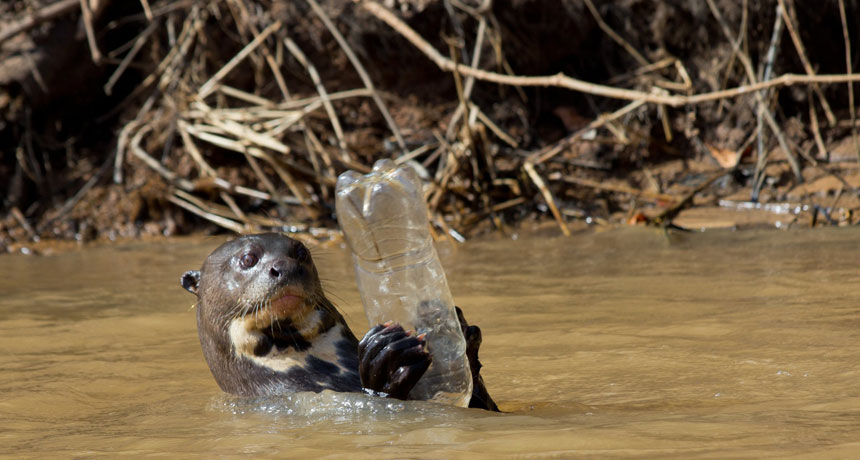Tiny particles help plastic break down in the sun
Teen creates new recipe for plastic that speeds its degradation in sunlight

An otter is playing with plastic bottle. A teen is now working to make plastic that will break down and go away for good.
Paul Williams/Flickr (CC-BY-NC 2.0)
Share this:
- Share via email (Opens in new window) Email
- Click to share on Facebook (Opens in new window) Facebook
- Click to share on X (Opens in new window) X
- Click to share on Pinterest (Opens in new window) Pinterest
- Click to share on Reddit (Opens in new window) Reddit
- Share to Google Classroom (Opens in new window) Google Classroom
- Click to print (Opens in new window) Print
WASHINGTON, D.C. — Tossing a plastic bag out of a car window isn’t just rude. It creates a huge problem. That’s because when plastic enters the environment, it can take years — if not a century — to go away. Worse, this litter can break down into microplastics, tiny particles that can move into rivers and oceans, where animals may mistake them for food. But Thomas Colburn, 17, has come up with a new recipe for plastic. This plastic breaks down into harmless carbon and gas. All it needs to do this is a bit of sunlight.
Thomas, a senior at Oak Ridge High School in Tennessee, is on his school’s cross-country team. He loves to run for miles along trails that surround his town. But he hated seeing plastic trash as he ran — trash that he would spot over and over again.
At the Governor’s Schools for the Sciences and Engineering, a summer program in nearby Knoxville, Thomas had the chance to create plastic polymers. These molecules are long chains of repeating groups of atoms, commonly used to make plastic. They can be found in everything from shopping bags to cell phone cases and even socks. As Thomas made the polymers, the teen began to think about ways to un-make them. What he learned might suggest ways to get rid of the plastic that litters his running paths.

The teen worked with four different types. “I focused on those that are most heavily littered,” he explains. These were polystyrene (POL-ee-STY-reen), better known as Styrofoam; the low-density polyethylene (POL-ee-ETH-ul-leen) used in shopping bags; the high-density polyethylene used in milk jugs; and the polyethylene terephthalate (TER-eh-THAAL-ate) used in soft-drink bottles.
He then chose four chemicals to add to these plastics: Titanium dioxide is a mineral best known as a white pigment. Zinc oxide can be found in sunscreen. Tungsten trioxide is used to fireproof fabric. And iron oxide is best known as rust. Each is also a photocatalyst and could be purchased as nanoparticles — materials that had been ground down to bits that were mere billionths of a meter in size.
All of the plastics came in the form of nurdles — tiny bits of plastic that are the building blocks for larger plastic products. The teen mixed different samples of nurdles with one each of the four photocatalysts, then heated each pairing to create a new plastic. After exposing these plastics to light, Thomas measured how fast each degraded.
Adding titanium dioxide to polyethylene plastics sped up their breakdown. “It would take 270 years for a [normal] milk jug” to break down in the presence of sunlight, Thomas says, “and 23 years with my additive.”
The small amounts of titanium dioxide he added — between 2 and 6 percent — didn’t seem to affect the plastic’s strength. Even better, the new plastics didn’t break down into microplastics. Instead, they degraded into organic (carbon-containing) compounds and gases, which should be safer for the environment.
Thomas showed off his results, here, at the Intel Science Talent Search. Run by Society for Science & the Public and sponsored by Intel Corp., the search brings 40 high school seniors to Washington each year. There they share their science with the public and compete for cash awards that currently total more than $1 million a year.
So far, Thomas has only exposed his plastics to sunlamps. He still needs to try them out in real sunlight. But he hopes that someday companies will use his findings to make plastic products that break down quickly after disposal. “Once [plastic] enters the ocean, it’s impossible to manage,” the teen notes. “I want to decrease [the damage] at the source.”
Follow Eureka! Lab on Twitter
Power Words
(for more about Power Words, click here)
chemical A substance formed from two or more atoms that unite (become bonded together) in a fixed proportion and structure. For example, water is a chemical made of two hydrogen atoms bonded to one oxygen atom. Its chemical symbol is H2O. Chemical can also be an adjective that describes properties of materials that are the result of various reactions between different compounds.
chemical engineer A researcher who uses chemistry to solve problems related to the production of food, fuel, medicines and many other products.
chemical reaction A process that involves the rearrangement of the molecules or structure of a substance, as opposed to a change in physical form (as from a solid to a gas).
degrade To break down into smaller, simpler materials — as when wood rots or as a flag that’s left outdoors in the weather will fray, fade and fall apart. (in chemistry) To break down a compound into smaller components.
environment The sum of all of the things that exist around some organism or the process and the condition those things create for that organism or process. Environment may refer to the weather and ecosystem in which some animal lives, or, perhaps, the temperature, humidity and placement of components in some electronics system or product.
HDPE (abbrev. HDPE) A strong, dense plastic made from petroleum. It is commonly used to make milk jugs, alternatives to lumber, as well as bottles for shampoo, hair conditioner and detergent. Such products tend to be labeled with a “2” — the recycling code number for HDPE.
Intel Science Talent Search An annual competition created and run by Society for Science & the Public and sponsored by Intel Corp. Begun in 1950, this event brings 40 research-oriented high school seniors to Washington, D.C. to showcase their research to the public and to compete for awards.
microplastic A small piece of plastic, 5 millimeters (0.2 inch) or smaller in size. Microplastics may have been produced at that small size, or their size may be the result of the breakdown of water bottles, plastic bags or other things that started out larger.
nanoparticle A small particle with dimensions measured in billionths of a meter.
nurdle A very small particle of plastic that is used as the raw material for making plastic products, such as shopping bags and soft-drink bottles.
organic (in chemistry) An adjective that indicates something is carbon-containing; a term that relates to the chemicals that make up living organisms. (in agriculture) Farm products grown without the use of non-natural and potentially toxic chemicals, such as pesticides.
particle A minute amount of something.
photocatalyst A substance that can trigger a chemical reaction when exposed to light.
plastic Any of a series of materials that are easily deformable; or synthetic materials that have been made from polymers (long strings of some building-block molecule) that tend to be lightweight, inexpensive and resistant to degradation.
polyethylene A plastic made from chemicals that have been refined (produced from) crude oil and/or natural gas. The most common plastic in the world, it is flexible and tough. It also can resist radiation.
polymer Substances whose molecules are made of long chains of repeating groups of atoms. Manufactured polymers include nylon, polyvinyl chloride (better known as PVC) and many types of plastics. Natural polymers include rubber, silk and cellulose (found in plants and used to make paper, for example).
polystyrene A plastic made from chemicals that have been refined (produced from) crude oil and/or natural gas. Polystyrene is one of the most widely used plastics, and an ingredient used to make a widely used white, rigid foam (often sold under the name Styrofoam).
Society for Science and the Public(or SSP) A nonprofit organization created in 1921 and based in Washington, D.C. Since its founding, SSP has been not only promoting public engagement in scientific research but also the public understanding of science. It created and continues to run three renowned science competitions: The Intel Science Talent Search (begun in 1942), the Intel International Science and Engineering Fair (initially launched in 1950) and Broadcom MASTERS (created in 2010). SSP also publishes award-winning journalism: in Science News (launched in 1922) and Science News for Students (created in 2003). Those magazines also host a series of blogs (including Eureka! Lab).
titanium dioxide A white, unreactive, solid material that occurs naturally as a mineral and is used extensively as a white pigment. It is also chemically reactive in the presence of sunlight.
tungsten A dense, heavy, white metallic element that has the highest melting point of all elements. It is strong and resistant to corrosion, even at the very high temperatures encountered while moving quickly through the Martian atmosphere.
zinc oxide A chemical — with the formula ZnO — made when one atom of zinc bonds to an atom of oxygen. Its reflective properties make it useful in a range of products, from paints to sunscreens. Its germ-killing properties make it useful in some medicines or cosmetics. It can even be used as a source of the mineral zinc in foods.